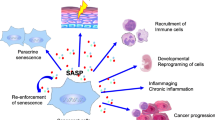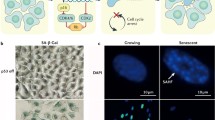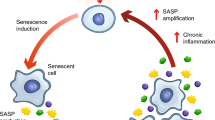Abstract
An increase in the burden of senescent cells in tissues with age contributes to driving aging and the onset of age-related diseases. Genetic and pharmacologic elimination of senescent cells extends both health span and life span in mouse models. Heterochronic parabiosis in mice has been used to identify bloodborne, circulating pro- and anti-geronic factors able to drive or slow aging, respectively. However, whether factors in the circulation also regulate senescence is unknown. Here, we measured the expression of senescence and senescence-associated secretory phenotype (SASP) markers in multiple tissues from 4- to 18-month-old male mice that were either isochronically or heterochronically paired for 2 months. In heterochronic parabionts, the age-dependent increase in senescence and SASP marker expression was reduced in old mice exposed to a young environment, while senescence markers were concurrently increased in young heterochronic parabionts. These findings were supported by geropathology analysis using the Geropathology Grading Platform that showed a trend toward reduced hepatic lesions in old heterochronic parabionts. In summary, these results demonstrate that senescence is regulated in part by circulating geronic factors and suggest that one of the possible mediators of the rejuvenating effects with heterochronic parabiosis is through the reduction of the senescent cell burden.



Similar content being viewed by others
References
Baker DJ, et al. Clearance of p16Ink4a-positive senescent cells delays ageing-associated disorders. Nature. 2011;479:232–6. https://doi.org/10.1038/nature10600.
Baker DJ, et al. Naturally occurring p16(Ink4a)-positive cells shorten healthy lifespan. Nature. 2016;530:184–9. https://doi.org/10.1038/nature16932.
Brack AS, Conboy MJ, Roy S, Lee M, Kuo CJ, Keller C, et al. Increased Wnt signaling during aging alters muscle stem cell fate and increases fibrosis. Science. 2007;317:807–10. https://doi.org/10.1126/science.1144090.
Bussian TJ, Aziz A, Meyer CF, Swenson BL, van Deursen JM, Baker DJ. Clearance of senescent glial cells prevents tau-dependent pathology and cognitive decline. Nature. 2018;562:578–82. https://doi.org/10.1038/s41586-018-0543-y.
Campisi J, d’Adda di Fagagna F. Cellular senescence: when bad things happen to good cells. Nat Rev Mol Cell Biol. 2007;8:729–40. https://doi.org/10.1038/nrm2233.
Carlson ME, et al. Relative roles of TGF-beta1 and Wnt in the systemic regulation and aging of satellite cell responses. Aging Cell. 2009a;8:676–89. https://doi.org/10.1111/j.1474-9726.2009.00517.x.
Carlson ME, Suetta C, Conboy MJ, Aagaard P, Mackey A, Kjaer M, et al. Molecular aging and rejuvenation of human muscle stem cells. EMBO Mol Med. 2009b;1:381–91. https://doi.org/10.1002/emmm.200900045.
Castellano JM, et al. Human umbilical cord plasma proteins revitalize hippocampal function in aged mice. Nature. 2017;544:488–92. https://doi.org/10.1038/nature22067.
Chang J, et al. Clearance of senescent cells by ABT263 rejuvenates aged hematopoietic stem cells in mice. Nat Med. 2016;22:78–83. https://doi.org/10.1038/nm.4010.
Childs BG, Baker DJ, Wijshake T, Conover CA, Campisi J, van Deursen JM. Senescent intimal foam cells are deleterious at all stages of atherosclerosis. Science. 2016;354:472–7. https://doi.org/10.1126/science.aaf6659.
Conboy IM, Conboy MJ, Wagers AJ, Girma ER, Weissman IL, Rando TA. Rejuvenation of aged progenitor cells by exposure to a young systemic environment. Nature. 2005;433:760–4. https://doi.org/10.1038/nature03260.
Conboy IM, Conboy MJ, Rebo J. Systemic problems: a perspective on stem cell aging and rejuvenation. Aging (Albany NY). 2015;7:754–65. https://doi.org/10.18632/aging.100819.
Coppe JP, Desprez PY, Krtolica A, Campisi J. The senescence-associated secretory phenotype: the dark side of tumor suppression. Annu Rev Pathol. 2010;5:99–118. https://doi.org/10.1146/annurev-pathol-121808-102144.
Csipo T, Lipecz A, Ashpole NM, Balasubramanian P, Tarantini S. Astrocyte senescence contributes to cognitive decline. Geroscience. 2020;42:51–5. https://doi.org/10.1007/s11357-019-00140-9.
Demaria M, et al. An essential role for senescent cells in optimal wound healing through secretion of PDGF-AA. Dev Cell. 2014;31:722–33. https://doi.org/10.1016/j.devcel.2014.11.012.
Farr JN, et al. Targeting cellular senescence prevents age-related bone loss in mice. Nat Med. 2017;23:1072–9. https://doi.org/10.1038/nm.4385.
Gorgoulis V, Adams PD, Alimonti A, Bennett DC, Bischof O, Bishop C, et al. Cellular Senescence: Defining a Path Forward. Cell. 2019;179:813–27. https://doi.org/10.1016/j.cell.2019.10.005.
Haque S, et al. circRNAs expressed in human peripheral blood are associated with human aging phenotypes, cellular senescence and mouse lifespan. Geroscience. 2020;42:183–99. https://doi.org/10.1007/s11357-019-00120-z.
Herbig U, Ferreira M, Condel L, Carey D, Sedivy JM. Cellular senescence in aging primates. Science. 2006;311:1257. https://doi.org/10.1126/science.1122446.
Jeon OH, et al. Local clearance of senescent cells attenuates the development of post-traumatic osteoarthritis and creates a pro-regenerative environment. Nat Med. 2017. https://doi.org/10.1038/nm.4324.
Katsimpardi L, et al. Vascular and neurogenic rejuvenation of the aging mouse brain by young systemic factors. Science. 2014;344:630–4. https://doi.org/10.1126/science.1251141.
Khan SY, Awad EM, Oszwald A, Mayr M, Yin X, Waltenberger B, et al. Premature senescence of endothelial cells upon chronic exposure to TNFalpha can be prevented by N-acetyl cysteine and plumericin. Sci Rep. 2017;7:39501. https://doi.org/10.1038/srep39501.
Kirkland JL, Tchkonia T, Zhu Y, Niedernhofer LJ, Robbins PD. The Clinical Potential of Senolytic Drugs. J Am Geriatr Soc. 2017;65:2297–301. https://doi.org/10.1111/jgs.14969.
Krishnamurthy J, Torrice C, Ramsey MR, Kovalev GI, Al-Regaiey K, Su L, et al. Ink4a/Arf expression is a biomarker of aging. J Clin Invest. 2004;114:1299–307. https://doi.org/10.1172/JCI22475.
Ladiges W. Pathology assessment is necessary to validate translational endpoints in preclinical aging studies. Pathobiol Aging Age Relat Dis. 2016;6:31478. https://doi.org/10.3402/pba.v6.31478.
Ladiges W, Ikeno Y, Niedernhofer L, McIndoe RA, Ciol MA, Ritchey J, et al. The Geropathology Research Network: An Interdisciplinary Approach for Integrating Pathology Into Research on Aging. J Gerontol A Biol Sci Med Sci. 2016;71:431–4. https://doi.org/10.1093/gerona/glv079.
Ladiges W, Snyder JM, Wilkinson E, Imai DM, Snider T, Ge X, et al. A New Preclinical Paradigm for Testing Anti-Aging Therapeutics. J Gerontol A Biol Sci Med Sci. 2017;72:760–2. https://doi.org/10.1093/gerona/glx019.
Lawrence I, et al. Correlations between age, functional status, and the senescence-associated proteins HMGB2 and p16(INK4a). Geroscience. 2018;40:193–9. https://doi.org/10.1007/s11357-018-0015-1.
LeBrasseur NK, Tchkonia T, Kirkland JL. Cellular senescence and the biology of aging, Disease, and Frailty. Nestle Nutr Inst Workshop Ser. 2015;83:11–8. https://doi.org/10.1159/000382054.
Lewis KN, Rubinstein ND, Buffenstein R. A window into extreme longevity; the circulating metabolomic signature of the naked mole-rat, a mammal that shows negligible senescence. Geroscience. 2018;40:105–21. https://doi.org/10.1007/s11357-018-0014-2.
Liendl L, Grillari J, Schosserer M. Raman fingerprints as promising markers of cellular senescence and aging. Geroscience. 2019. https://doi.org/10.1007/s11357-019-00053-7.
Loffredo FS, et al. Growth differentiation factor 11 is a circulating factor that reverses age-related cardiac hypertrophy. Cell. 2013;153:828–39. https://doi.org/10.1016/j.cell.2013.04.015.
Munoz-Espin D, Serrano M. Cellular senescence: from physiology to pathology. Nat Rev Mol Cell Biol. 2014;15:482–96. https://doi.org/10.1038/nrm3823.
Musi N, Valentine JM, Sickora KR, Baeuerle E, Thompson CS, Shen Q, et al. Tau protein aggregation is associated with cellular senescence in the brain. Aging Cell. 2018;17:e12840. https://doi.org/10.1111/acel.12840.
Palmer AK, Xu M, Zhu Y, Pirtskhalava T, Weivoda MM, Hachfeld CM, et al. Targeting senescent cells alleviates obesity-induced metabolic dysfunction. Aging Cell. 2019;18:e12950. https://doi.org/10.1111/acel.12950.
Patil P, et al. Systemic clearance of p16(INK4a) -positive senescent cells mitigates age-associated intervertebral disc degeneration. Aging Cell. 2019;18:e12927. https://doi.org/10.1111/acel.12927.
Rebo J, Mehdipour M, Gathwala R, Causey K, Liu Y, Conboy MJ, et al. A single heterochronic blood exchange reveals rapid inhibition of multiple tissues by old blood. Nat Commun. 2016;7:13363. https://doi.org/10.1038/ncomms13363.
Roos CM, et al. Chronic senolytic treatment alleviates established vasomotor dysfunction in aged or atherosclerotic mice. Aging Cell. 2016;15:973–7. https://doi.org/10.1111/acel.12458.
Schafer MJ, White TA, Evans G, Tonne JM, Verzosa GC, Stout MB, et al. Exercise Prevents Diet-Induced Cellular Senescence in Adipose Tissue. Diabetes. 2016;65:1606–15. https://doi.org/10.2337/db15-0291.
Schafer MJ, White TA, Iijima K, Haak AJ, Ligresti G, Atkinson EJ, et al. Cellular senescence mediates fibrotic pulmonary disease. Nat Commun. 2017;8:14532. https://doi.org/10.1038/ncomms14532.
Sharpless NE, Sherr CJ. Forging a signature of in vivo senescence. Nat Rev Cancer. 2015;15:397–408. https://doi.org/10.1038/nrc3960.
Smith LK, et al. beta2-microglobulin is a systemic pro-aging factor that impairs cognitive function and neurogenesis. Nat Med. 2015;21:932–7. https://doi.org/10.1038/nm.3898.
Tchkonia T, Zhu Y, van Deursen J, Campisi J, Kirkland JL. Cellular senescence and the senescent secretory phenotype: therapeutic opportunities. J Clin Invest. 2013;123:966–72. https://doi.org/10.1172/JCI64098.
Villeda SA, et al. The ageing systemic milieu negatively regulates neurogenesis and cognitive function. Nature. 2011;477:90–4. https://doi.org/10.1038/nature10357.
Villeda SA, et al. Young blood reverses age-related impairments in cognitive function and synaptic plasticity in mice. Nat Med. 2014;20:659–63. https://doi.org/10.1038/nm.3569.
Waaijer ME, et al. The number of p16INK4a positive cells in human skin reflects biological age. Aging Cell. 2012;11:722–5. https://doi.org/10.1111/j.1474-9726.2012.00837.x.
Wang C, Jurk D, Maddick M, Nelson G, Martin-Ruiz C, von Zglinicki T. DNA damage response and cellular senescence in tissues of aging mice. Aging Cell. 2009;8:311–23. https://doi.org/10.1111/j.1474-9726.2009.00481.x.
Xu M, Palmer AK, Ding H, Weivoda MM, Pirtskhalava T, White TA, et al. Targeting senescent cells enhances adipogenesis and metabolic function in old age. Elife. 2015;4:e12997. https://doi.org/10.7554/eLife.12997.
Xu M, Pirtskhalava T, Farr JN, Weigand BM, Palmer AK, Weivoda MM, et al. Senolytics enhance physical function in old age and extend post-treatment survival. Nat Med. 2018;8:1246–56. https://doi.org/10.1038/s41591-018-0092-9.
Yousef H, et al. Systemic attenuation of the TGF-beta pathway by a single drug simultaneously rejuvenates hippocampal neurogenesis and myogenesis in the same old mammal. Oncotarget. 2015;6:11959–78. https://doi.org/10.18632/oncotarget.3851.
Yousefzadeh MJ, et al. Circulating levels of monocyte chemoattractant protein-1 as a potential measure of biological age in mice and frailty in humans. Aging Cell. 2018a;17. https://doi.org/10.1111/acel.12706.
Yousefzadeh MJ, et al. Fisetin is a senotherapeutic that extends health and lifespan. EBioMedicine. 2018b;36:18–28. https://doi.org/10.1016/j.ebiom.2018.09.015.
Yousefzadeh MJ, Melos KI, Angelini L, Burd CE, Robbins PD, Niedernhofer LJ. Mouse Models of Accelerated Cellular Senescence. Methods Mol Biol. 2019;1896:203–30. https://doi.org/10.1007/978-1-4939-8931-7_17.
Yousefzadeh MJ, et al. Tissue specificity of senescent cell accumulation during physiologic and accelerated aging of mice. Aging Cell. 2020:e13094. https://doi.org/10.1111/acel.13094.
Zhang P, et al. Senolytic therapy alleviates Abeta-associated oligodendrocyte progenitor cell senescence and cognitive deficits in an Alzheimer's disease model. Nat Neurosci. 2019;22:719–28. https://doi.org/10.1038/s41593-019-0372-9.
Zhu Y, et al. The Achilles’ heel of senescent cells: from transcriptome to senolytic drugs. Aging Cell. 2015;14:644–58. https://doi.org/10.1111/acel.12344.
Acknowledgments
This work was supported by R21 AG055026 (DMH), R01 AG044376 (NV), U19 AG056278 (LJN, WCL, PDR), PO1 AG043376 (PDR, LJN), R01 AG063543 (LJN), R56 AG059676 (LJN), R56 AG4059675 (PDR), P01 AG062412 (PDR, LJN) and the American Federation for Aging Research (DMH), as well as the Einstein Nathan Shock Center (P30 AG038072) and Einstein Cancer Center (P30 CA013330). MJY is supported by The Irene Diamond Fund/American Federation on Aging Research Postdoctoral Transition Award. The authors would like to thank Mariah Witt for editing the manuscript.
Author information
Authors and Affiliations
Corresponding authors
Ethics declarations
Conflict of interest
The authors declare that they have no conflict of interest.
Ethical declaration
Animal studies were performed in accordance with the Institutional Animal Care and Use Committee at the Albert Einstein College of Medicine.
Additional information
Publisher’s note
Springer Nature remains neutral with regard to jurisdictional claims in published maps and institutional affiliations.
Electronic supplementary material
Supplementary Table 1
(DOCX 12 kb).
About this article
Cite this article
Yousefzadeh, M.J., Wilkinson, J.E., Hughes, B. et al. Heterochronic parabiosis regulates the extent of cellular senescence in multiple tissues. GeroScience 42, 951–961 (2020). https://doi.org/10.1007/s11357-020-00185-1
Received:
Accepted:
Published:
Issue Date:
DOI: https://doi.org/10.1007/s11357-020-00185-1




